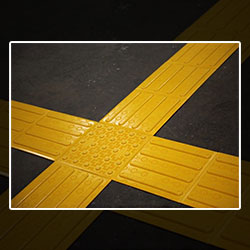









Creating accessible and navigable spaces is crucial, especially for visually impaired individuals. Wayfinding tiles enhance accessibility by providing non-visual cues to guide users safely through public areas.
This comprehensive guide will explore what wayfinding tiles are, their significance, types, applications, installation, and codes & standards concerning wayfinding tiles in Canada.
Wayfinding tiles, also known as directional tiles or tactile guidance tiles, are specialized tactile walking surface indicators (TWSIs) designed to assist visually impaired individuals in navigating safely in public spaces.
These tiles contain raised bars that can be felt underfoot or by a cane. The bars are oriented in the direction of travel, providing a tactile cue for path navigation. Wayfinding tiles are installed in large open spaces to define accessible routes from point A to B for the visually impaired.
For individuals with visual disabilities, navigating unfamiliar, expansive spaces can be challenging. Wayfinding tiles provide an invaluable and accessible means of facilitating independent mobility.
Some key benefits of wayfinding tiles include the following:
Overall, wayfinding tiles crucially enhance accessibility, safety, and independence for blind or low-vision users in environments like transit stations, shopping malls, offices, etc.
Wayfinding tiles are available in various materials, sizes, colors, and installation formats. Common options include:
Wayfinding tiles have diverse applications across indoor and outdoor settings, including:
Indoors:
Wayfinding tiles can be installed along accessibility routes leading from entryways to key destinations like information desks, elevators, escalators, stairs, transit platforms, etc. They provide continuous tactile guidance throughout the space.
For optimal effectiveness, wayfinding tiles must adhere to certain specifications per accessibility guidelines and codes. Key specifications include:
Several crucial regulations and standards concerning wayfinding tiles must be complied with in public installations in Canada. These include:
Installing compliant wayfinding tiles per all relevant codes ensures accessibility obligations are legally met. Non-compliance can result in heavy penalties and lawsuits.
Proper installation is vital for wayfinding tiles to function effectively. Here are some best practices to follow:
Proper installation Alignment perpendicular to route direction, flushness with the floor, high color/brightness contrast, and ongoing maintenance are vital for optimizing wayfinding tile functionality.
Wayfinding tiles use various durable and slip-resistant materials like polymers, metals (stainless steel, cast iron, aluminum), rubber, and porcelain.
The principal regulations are the Accessibility for Ontarians with Disabilities Act (AODA), CSA B651, the National Building Code of Canada, provincial building codes like the Ontario Building Code, and relevant municipal bylaws.
Wayfinding tiles should be regularly inspected for damage or uplift, with prompt replacement of defective tiles. Daily sweeping and spot mopping keep tiles free of dust/debris accumulation.
Truncated domes provide warnings of upcoming hazards, while wayfinding tiles contain directional bars or cones to guide users along an intended pedestrian circulation path.
Wayfinding tiles provide a tactile navigation channel for the blind and visually impaired, enabling accessible mobility in complex environments. By consulting codes and standards, selecting appropriate products, and following best practices for installation, maintenance, and usability testing, facility owners and contractors can integrate wayfinding tiles to create inclusive public spaces that accommodate all users. This comprehensive guide covered the critical aspects of wayfinding tiles, from significance and design to installation and compliance. Leverage the insights provided to make wayfinding tiles a key component of accessibility and universal design in your next public space project.
